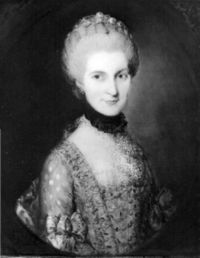Annotation:Lady Mary Powiss's Minuet
Back to Lady Mary Powiss's Minuet
LADY MARY POWIS'S MINUET. AKA - "Lady Mary Powess's Minuet." English, Scottish; Minuet. D Major. Standard tuning (fiddle). AABBCCDD. The melody appears in the (James) Gillespie Manuscript of Perth (1768) and in the manuscript collection of Colonial dancing master John Ormsby, who transcribed it in Annapolis in about 1758. The tune appears to have been first published in London publisher David Rutherford's The Art of Playing on the Violin (1755, p. 17).

Lady Mary Brudenell (1717-1813) was the daughter of George Brudenell, 3rd Earl of Cardigan and Lady Elizabeth Bruce, and sister of the 4th Earl of Cardigan. She married firstly Richard Powis (or Powys) esq. in 1735, a Member of Parliament who lived at Hintlesham Hall, Suffolk, and with whom she had two children. Secondly she wed Thomas Boulby esq. of the Bishoprick of Durham, in 1754, a protégée of the Duke of Northumberland and a member of Horace Walpole's circle. She lived nearly a century, outliving her second husband by nearly twenty years. Mary and her husband are mention in Lady Louisa Stewart's Memoire of Frances, Lady Douglas (Scottish Academic Press, 1985):
Lord William (Gordon) I must enlarge upon, as the duke of Buccleugh's old friend, and the very life and soul of the Dalkeith coteries in town and country. He was a character, an original; odd, clever, beyond measure entertaining; one of those people who appear to have bullied the world out of an unlimited license to say and do whatsoever they please. Upon any extraordinary speech or extravagant action, his friends coolly observed - "Ah! that is so like him!" - Others asked - "will he never shut up?" - alluding to the family malady - but neither gave it a second thought. Wherever he gained a footing there he was master, sure to govern. You knew not how or why, but the whole family, men, women, chidlren, dogs and cats obeyed him; nobody disputed his pleasure: nor could any body make a stand against him whom he disliked or had a mind to turn to ridicule. He set about it above board, visibly and audibly, with such force of humour, that , pleased or displeased, all held their sides except the victim. For instance, Mr. Bowlby, a shallow affected old coxcomb - but the Duchess's uncle -gave himself the air of sentimentally languishing for Lady Morton. I have known Lord William sitting at supper in Grosvenor Square directly opposite to them, talk (more than half aloud) of Philander and Celia, Strephon and Chloris; expatriate - regardless of hush and fye from every side- upon faithful knights, and enamoured swains, and pastoral love, and platonic love , and Lord knows how much more nonsense, 'till the whole company tired of hatching coughs and almost swallowing their handkerchiefs laughed our in chorus. The duke and duchess declared it too bad but laughed like the rest. After one of these scenes, Lady Mary Bowlby, seriously incensed, would not speak to him. Then the joke was to entrap her into it against her will; watching her looks, and playing all sorts of monkey-tricks to extort a monosyllable by surprise.
Source for notated version: the music manuscript of Captain George Bush (1753?-1797), a fiddler and officer in the Continental Army during the American Revolution [Keller].
Printed sources: Keller (Fiddle Tunes from the American Revolution), 1992; p. 11.
Recorded sources:
Back to Lady Mary Powiss's Minuet
